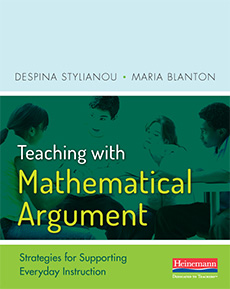Strategies to Teach Math Through Argument
Teaching with Mathematical Argument: Strategies for Supporting Everyday Instruction
By Despina Stylianou and Maria Blanton
(Heinemann, 2018 – Learn more)

What caught my eye with this book was the title. Argument. I wasn’t sure if that was what I was looking for as part of my classroom. As it turned out, the book solidified and reinforced some strategies that I already use.

I appreciated that the book starts out defining argumentation and concludes with assessment. All of the steps are laid out in the chapters with examples from classrooms: the task, student work, and how the teacher supported the students.
Adding argument to the math classroom
Argument was a difficult word for me to accept. The authors refer argument back to one of the eight Standards for Mathematical Practice. That made more sense to me. Argument is a conversation – as they write, “argumentation is a pivotal tool that guides mathematical discourse and helps us navigate the terrain of mathematics.” That is so true! I discovered I already encourage student argumentation.
Argumentation moves students away from being answer focused and promotes thinking and reasoning to deepen their mathematical understanding. Understanding grows “when they explain how they reached those solutions, shifting from the answer to the process and why the process is appropriate.” This leads students to become actively involved in the classroom and mathematics.
From parents to classroom management
While I was reading the book, I was thinking about conversations with parents. Most parents want their student to solve using the algorithm and to move on. Teaching with Mathematical Argument gave me the tools to better communicate with parents the importance of students reasoning and being able to communicate their mathematical understanding to others.
Classroom management is also an important aspect of this book. The authors address how to help students build viable arguments while showing respect for classmates. This section helped solidify some of my classroom practices. These expectations need to be set at the beginning of the school year.
The section on assessment gives guidance on both formative and summative strategies. I was disappointed that there were not more ideas provided. I will modify the rubric that is included. Research that supports the use of argumentation to improve state testing scores would be interesting. We have a lot of pressure on us for our students to perform. I need to be able to make the case that this class time is well spent.
Effective questioning
Questioning is an area that I struggle with in getting mathematical discussions to a higher level. Different levels of questioning are explored throughout the book, which offers both questions you can ask and the level of question. The authors provide examples of student dialogue that are very helpful. A technique that I use for implementing new strategies is to display – somewhere in the classroom – what I want students to be able to do. When I look back over the book, I will be writing down the probing questions to have available in class.
Teaching with Mathematical Argument supports what most teachers are already doing in class to some degree. It is not a whole new program to implement. The focus is on strategies to support students in reasoning through the mathematical challenges, sharing and listening to other students, and really paying attention to peers to understand their reasoning and using what they perceive to further their learning. I will begin implementing some of the key strategies in this book in my classroom as part of everyday instruction.
Middle school has been Cynthia McBride‘s teaching arena for the past 20 years. She teaches sixth grade math and recently earned a Teacher Leadership Institute badge. Math is a challenging curriculum to teach. She tries to debunk the myth of students and parents saying, “I am bad at math.” Her answer: “Math just needs to be practiced!”



































